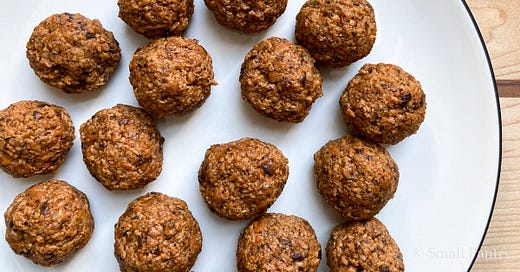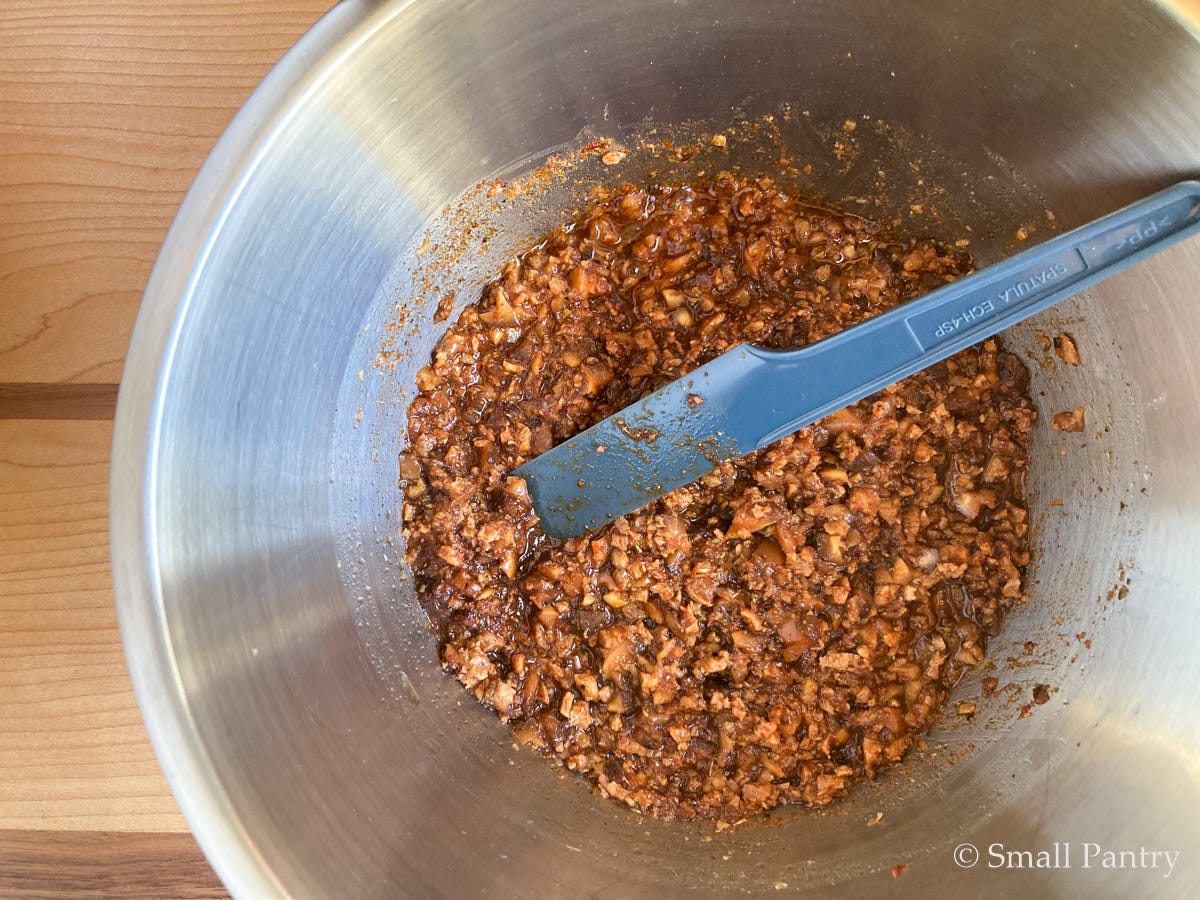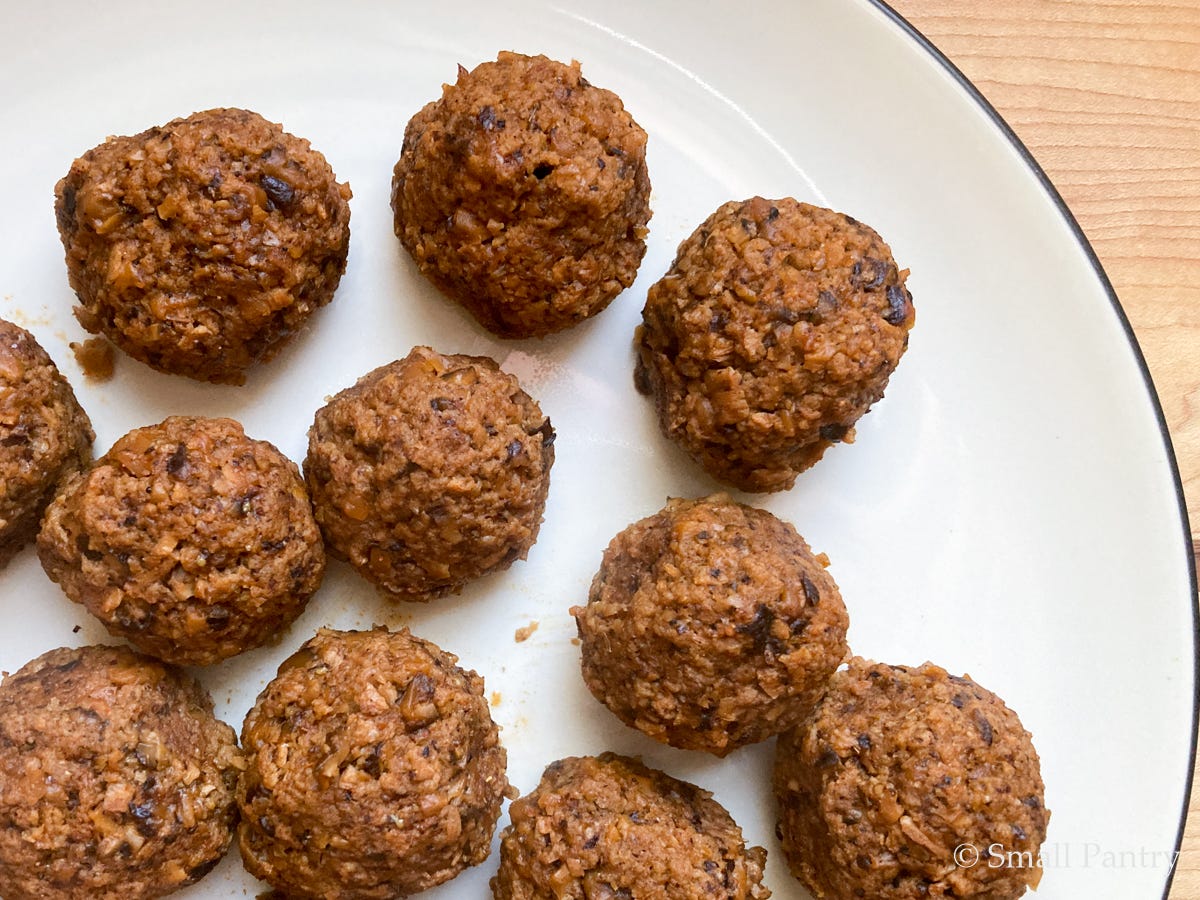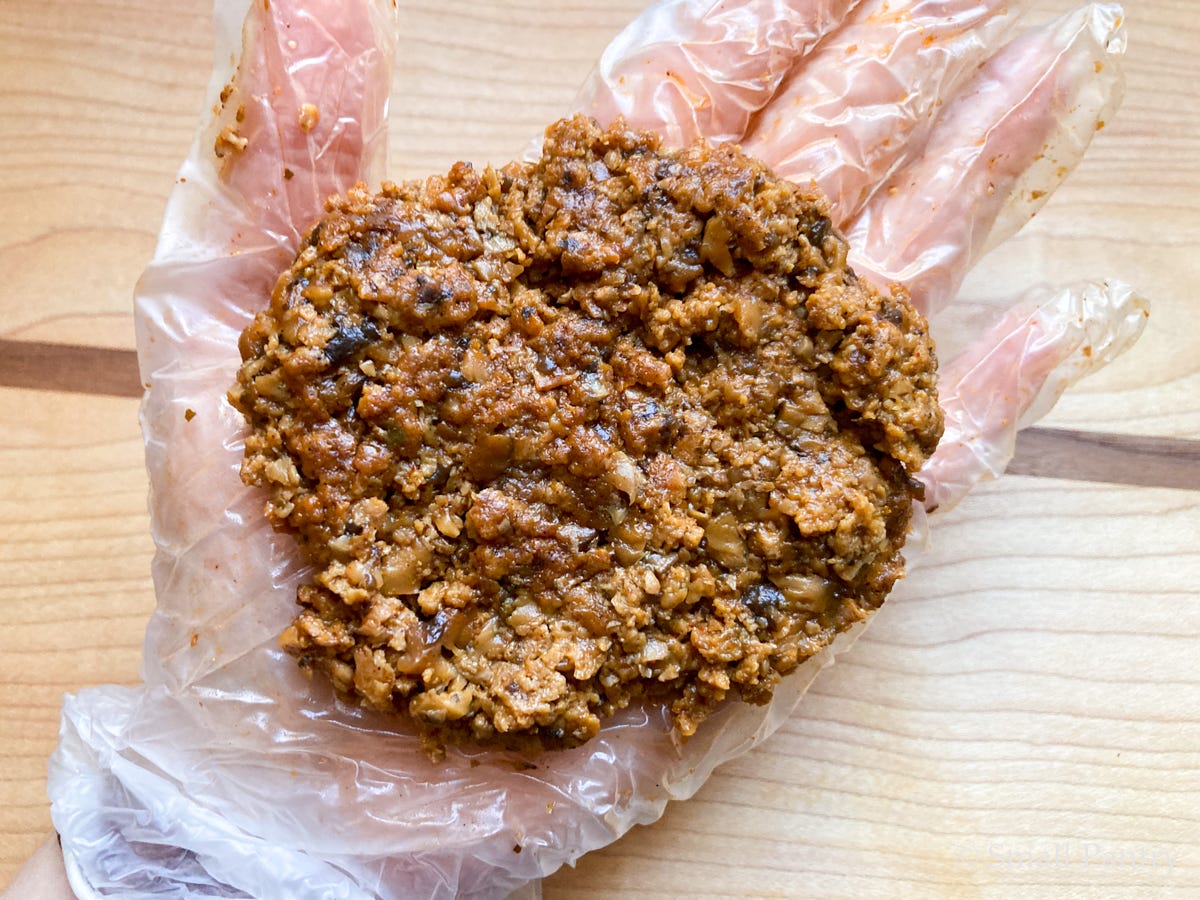Hello and welcome to another installment of “No Meat? No Problem!” the series in which I mash up planty particles and douse them with paprika, then eat the results in breakfast burritos and tacos for the next 5 days! For Science!
This kind of kitchen tinkering is something that I enjoy regardless, but earlier this week Alicia Kennedy sent out a newsletter that reminded me why I started on this project. It’s a quick read, so I’ll link it here: A Brief Note on Beef (Kennedy).
I do really think you should hop over and read the newsletter in its entirety, as her point is an important and relevant response to one of the many toxic threads of misinformation being spread in the current political landscape. However, for the sake of making my point, I’m copying a few of her lines below:
I know some people will argue that they’re a conscientious omnivore who sources well. No doubt there are many of you! […] There is no way for “grass-fed,” “regenerative,” or “[insert your buzzword here]” animal farming practices to produce the amount of meat people are accustomed to: decreased consumption is absolutely necessary. Not even the ranchers can argue with that, if they’re being honest. […] People’s responses to food are emotional and nostalgic, and in a country like the United States, where meat represents affluence, nourishment, and well-being, the issues get muddled. […] But eating beef without care for its effects on the environment in the U.S. in 2025 is functionally climate denialism. Reality is and has been quite clear: Affluent people in the U.S. need to cut back on meat and dairy because they’re bad for the planet, the animals, and the workers. If this cuts into your fun times, re-consider your fun.”
Now, I understand if after reading that you’re feeling emotionally itchy: “Julia, why are you getting political?? I signed up for this newsletter for recipes and fun kitchen content, not to be lectured about politics!”
I get it. I do. It makes me feel uncomfortable, too. But if we sit with that for just a few breaths, it’s easy to see that our discomfort likely comes from A) knowing that she’s right, that climate activists have been right, and B) feeling like a source of comfort, pleasure, and convenience might be taken away if we completely accept and lean into that uncomfortable reality.
We know how to cook meat. We know how to make it taste good. It’s how we were raised. A huge amount of grocery store real estate is dedicated to pairing pre-boxed ingredients and sauces with meat. Buy a packet of taco seasoning and a pound of ground beef and you’ll have dinner. Bags of frozen veggies come printed with instructions for pairing with sliced chicken breast for an easy stir-fry. It’s easy to anchor our meals with meat because it’s familiar and because there are so very many products out there dedicated to (cheaply) making meat easy. (How many dinners in this McCormick commercial don’t feature dumping a spice packet into a skillet of meat?)
If we decide to eat less or no meat we lose our familiar anchor. Without the convenience of a boneless skinless chicken thigh, dinner requires more thought and energy. Have you ever had a vegetarian or vegan relative coming over for a visit and felt anxious about what on earth you were supposed to feed them? It’s unfamiliar territory for many of us! Changing our comfort zones is possible, but the learning and practice required to do so take time and effort—two resources that are often in short supply.
Ultimately, I think fake meat that is engineered to look and taste like animal protein is a crutch. Idealistically, we shouldn’t lean on that crutch because it still perpetuates the fundamental issue of centering our food culture around meat and its industry. But let’s get literal: what is the purpose of a crutch? It’s something that takes you where you need to go when you can’t do it on your own. Crutches are inelegant, imperfect solutions, but it’s okay to need them. Expanding and growing our comfort zones is journey and a process.
So that is what I am sharing with you today: a chorizo crutch update. My hope is that at the end of this development project we will have an array of easy, inexpensive ground meat alternatives that can help us on our collective mission of eating less meat. I want my recipes to be convenience-comfort foods. Something that helps with both meal planning and nostalgic cravings. And, I am pleased to say, this particular round of testing was my most promising and most delicious! So andiamo, mi amici! Let’s talk chorizo, seitan, and chorizo seitan!
♥♥♥
Hey there! Cooking for friends and family is a love-language, am I right? Well, let’s take that love and spread it as far as we can! Especially now, with an uncertain future looming, I suggest seeking out local nonprofits that support mutual aid endeavors like community fridges and advocacy for your unhoused neighbors? Or perhaps supporting organizations that provide critical support for Trans youth? I also encourage finding ways to support anti-genocide efforts and relief aid in Palestine, such as through organizations like Anera.
♥♥♥
Why vital wheat gluten (seitan):
First, to make sure we’re all on the same page, a quick bit of context: Seitan is a wheat-based meat alternative. It’s not new. At its most simple, you make seitan by combining wheat flour with water, kneading to form gluten, then washing the dough in water to dissolve the starches. The gluten stays intact as the starches wash away, leaving you with an elastic, high-protein dough. It must be fully cooked to set the structure (usually steamed or poached), and if cooked properly it has a firm, bouncy, meaty texture that can be flavored and seared as you would most whole-muscle meats.
Vital wheat gluten streamlines this process. The wheat starches have already been separated out, so all the home cook has to do is add water and knead.
I don’t want to make a straight-forward seitan, because our whole goal here is to replicate ground meat, not chicken breast or pulled pork! My thought is that I might be able to use some vital wheat gluten as a binder to harness seitan’s bouncy, meaty texture while still maintaining a ground meat structure.
The ingredients:
I’m keeping my spices the same, including the switch to grated fresh garlic instead of garlic powder. I’ll be using vital wheat gluten (VWG) as a binder instead egg, psyllium husk, or chickpea flour.
To get a jumping off point for the amount of VWG I should start with, I leaned on this recipe. It calls for a significant amount of lentils and walnuts, similar to the TVP and mushrooms that I’m adding to mine.
The method:
My method stayed mostly the same: hydrate then mince dried mushrooms, combine with the umami broth, spices, TVP, and hot water. Let soak.
Once the TVP was hydrated, I portioned out some of the mix to blend into a paste. After returning that paste to the bowl, I added the VWG and kneaded to encourage gluten formation.
After kneading, I formed the mix into meatballs. I did this because the seitan recipe I was riffing on was a meatball recipe, and I wanted to use her cook times. I plan to move away from the meatball shape in future tests.
Seitan needs to be pre-cooked to set the gluten and create that bouncy, meaty texture we’re after. These meatballs were steamed for 30 minutes. They puffed up significantly, but it’s kind of hard to tell in the before and after shots (above and below, respectively).
The results:
Once seitan is steamed it can technically be eaten, but most of the time you’ll want a second cook for searing and crisping. I seared off two of the steamed meatballs, then crumbled and sauteed a third as I would cook bulk chorizo for burritos or tacos.
The meatballs seared quickly and got a nice caramel brown crust. When crumbled, I got a range of sizes, from tiny morsels that got very crispy to larger, more meaty chunks.
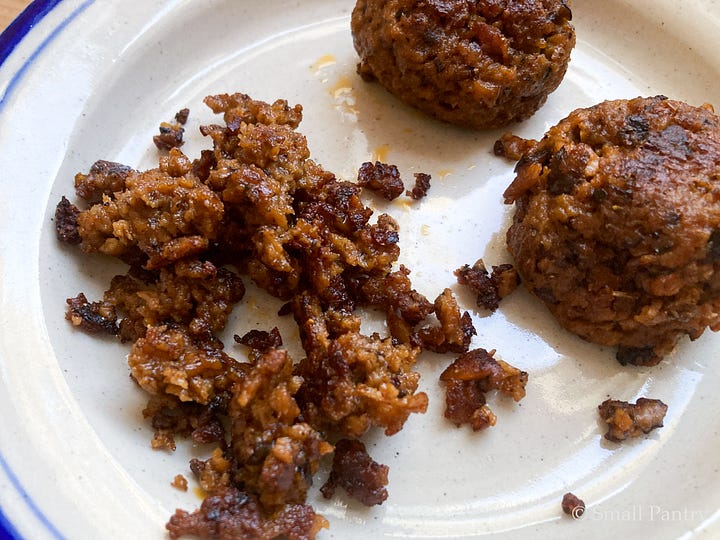
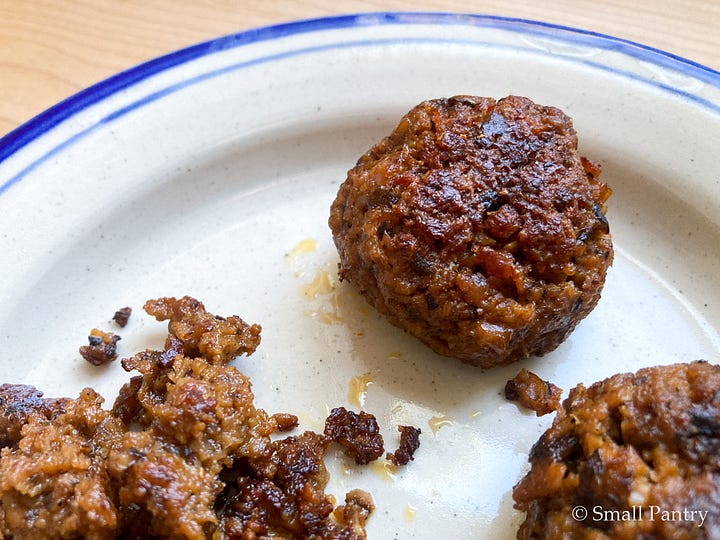
The flavor was good overall—tasty but mild in comparison to previous non-VWG tests. Happily, there was none of that bready flavor that store-bought seitan often has. The texture was GREAT. They might look a bit soft in the photos, but they have the wonderful, juicy bounce that I’ve been hunting for. The parts that browned were the perfect crispy texture.
On a whim, I tried mushing two of the steamed chorizo balls into a patty—thinking ahead to burgers or breakfast sausage patties. Unsurprisingly, they smushed together okay in my hand, but completely fell apart in the skillet. Ideally I’d like to be able to make the sausage/mince, steam it, then decide later what shape it will be, rather than have to commit to balls/links/patties right away.
Final Notes
For my next round of testing, I’m going to ditch the balls in favor of steaming everything in bulk, then play with ways to make shaping patties post-steam more successful. I haven’t started the faux-beef flavor journey yet, but can you tell I’m trying to set myself up for burger bliss?? I’m also going to try decreasing the amount of minced mushroom-TVP blend. If the current texture ends up being the best I can get then I’m quite satisfied, but I suspect there is still room to firm everything up a bit more. I’m also thinking of pivoting away from TVP entirely for a few tests. Since I’ve abandoned gluten-free (for now), perhaps I should at least make the base soy-free! I also need to convert the volume measurements for all the spices into grams, for easier cost analysis. I think it’s finally time to see if this recipe really is cheaper by weight than Beyond and Impossible!
Thanks for reading! Stay tuned for more cozy recipes and more behind the scenes adventures in my tiny home kitchen laboratory.
Until next week, be well!
xoxo Julia

